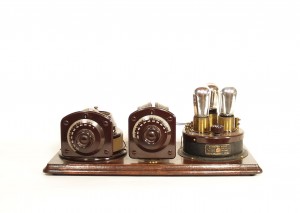Item: Excellent, Working 1923 Atwater Kent Model 2 Breadboard Radio
Sold For: $2,125.00
Bids: 30
Date: Apr 08, 2012
Auction: Ebay
Seller: firebottles
Feedback: 100% (1847)
Description and Image By: firebottles
Make sure to check out all of my auctions this week. I’m listing 4 gorgeous antique radios and a beautiful Pathe Cathedral Cone Loudspeaker. All of these items are in excellent to near mint condition, and all of them still work. Among the items on the block are a 1922 Kennedy Type 281 regenerative radio (a DX-er’s dream), a 1926 Splitdorf Abbey radio (with 6 exposed tubes peeping out of an etched copper panel), and a 1922 Tuska Type 224 One-Tube regenerative radio (museum quality throughout, with a pristine cabinet finish and a superb gold and black lid decal). So don’t forget to click “see other items” after you’ve read about this one. You can also click this link to quickly add and then save me to your favorite seller list and Ebay will automatically send you updates when I put similar new listings online. Please note, however, that this software glitches occasionally, and it’s not uncommon for bidders to be notified of new auction listings after those auctions have ended, so it’s always safest to check in Monday morning, as I list items every Sunday night.
Here’s an Atwater Kent 3945 breadboard, also known as the Model 2. The radio is a home-wired set constructed with authentic Atwater Kent parts manufactured in the early 1920’s; the condition of the parts (and of the mahogany board) is excellent. The 3-Tube detector amplifier island is a ca. 1923/24 1/4 amp unit designed for either bakelite base or brass base, tipped 01A tubes.
As you can see in the photos, the radio is clean throughout. Coupled Circuit tuner is in excellent shape, with unstained wiring still neatly wrapped around the coil forms. Mounted Variometer is also in also in excellent shape. The backing plate on the variometer has been shielded with a thin copper sheet to reduce hand capacitance while the radio is being operated. The TA island is pristine, with original black crackle paint that evidences hardly any wear. There’s no flaking paint along the base flange, nor is there any rust or corrosion eating away under the surface of the enamel. Rheostat still turns easily and works properly. Potting tar and wiring are original, and both of the original audio transformers are good.
Bakelite on all three components is still glossy and in excellent condition. Backing plates on the Coupled Circuit tuner and Mounted Variometer are in excellent condition. There are no chips, no cracks, no gouges, nor any hairlines on any of the bakelite parts. The mahogany plank is in excellent condition. The end caps have minimal gapping and are still tightly adhered to the main board.
As noted above, this is a working radio. If you want to operate it, you’ll need a good regulated DC power supply (I’d recommend an ARBEIII), a longwire outdoor antenna (ham radio type; at least 90 feet long and 20 feet off the ground); a good indoor ground connection; and a set of 1920’s headphones or a 1920’s horn loudspeaker. If you’re not familiar with how to tune a 1920’s era set, it’s going to take you some time to learn how to use it; you don’t simply power it up and turn the dial until you find a station like you do with an AC set. The radio comes with 3 good bakelite base 01A globe tubes. If you have the proper equipment on hand to use it, it will be ready to play as soon as it arrives.
That’s about it. I will double-box everything and pack it carefully and properly, and I can assure you that the radio and its tubes will show up at your doorstep in the same fine condition in which they leave mine. I have been shipping antique phonographs and radios for years, and if you check my feedback, you’ll see that I know how to do it correctly.

